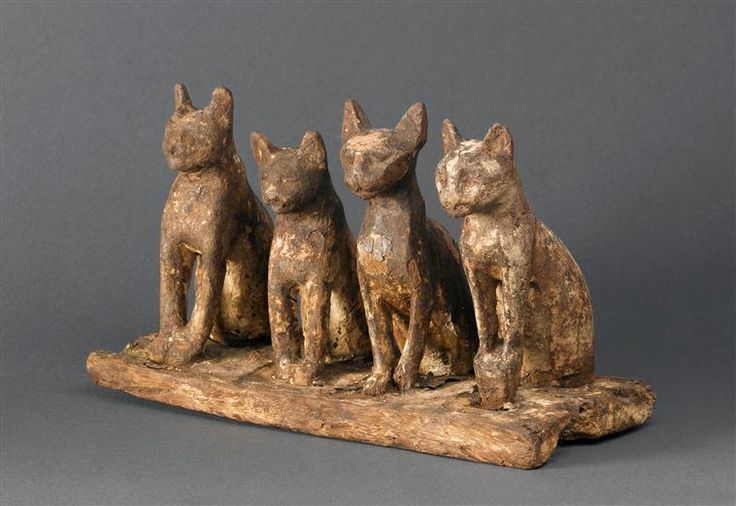Bastet, also known as Bast, was an ancient Egyptian goddess who originally had the role of protecting the Pharaohs. The inhabitants of the lower Nile depicted Bastet as a savage, lion-headed deity. After 1000 BCE, the Egyptians altered her image to the body of a woman and the head of a domesticated cat. Along with her change in appearance, she was also transformed into a peaceful and approachable deity. Instead of Bastet protecting Pharaohs, she was now a nurturer and protector of all households. Families soon began to invite cats inside their homes, thinking that they brought with them the spirit of Bastet. They worshiped these cats because they also hunted mice, snakes, and other pests that ruined their crops and their perishable goods. Bastet’s role as a goddess was further altered when she acquired the trait of fertility. Women would purchase pendants with Bastet and multiple kittens to enhance their fertility.1

Statues and depictions of Bastet vary. She transforms from a beast with a female lion’s head, to a woman with the head of a cat, to a regular black cat with kittens who sometimes held a rattle. Some thought the rattle was actually a musical instrument called a sistrum. Because of this, Bastet was also associated with music and dance. Soon after the sistrum was added to Bastet’s image, the Egyptians used the instrument at festivals where they would worship Bastet. Then, Bastet was depicted wearing a decorative dress, carrying the sistrum in her right hand and a shield in her left, with a bag over her arm.2
The Egyptians had an explanation for why she was transformed from a savage beast to a fertility and music goddess. Bastet was the daughter of Ra, the sun god who was vengeful. From him she got her aggressiveness. Her mother is unknown, but the Egyptians suspect that Ra sent young Bastet to Nubia as a lioness in isolation. There she was able to let out her rage, and then wander back to Egypt as a docile cat. Later an unknown king proclaimed that Bastet was his mother. Egyptian women then believed worshiping her would provide them with many children, as house cats would typically have up to twelve kittens; and one of her sons became king. Experts believe that the baby rattle was mistakenly interpreted as a sistrum, which led to her being known as a music and dance goddess.3

In depictions of wars on the walls of palaces, she was portrayed as a lion, and in homes she was a cat. Although Bastet was a goddess with many traits, that was not all that uncommon. In ancient Egypt gods and goddesses often served more than one purpose. Along with her most common traits, she was also thought of as the goddess of the sun, which she inherited from her father, as well as the goddess of physical pleasure. It was even believed that if a cat ran through a fire, the fire would be put out; therefore, she became the deity of firefighters.4
It is undeniable that Bastet was highly respected. Experts are still unable to determine when Egyptians first began to worship her as well as when her presence faded. Many statues of Bastet and mummified cats have been discovered along the lower Nile, which has led experts to believe that festivals were held there in her honor and locals worshiped her to the highest degree. Although she did have many roles, she is best known as the goddess of protection.5
“His totem animal in black onyx
erect on her haunches poised and aware
he brings in a dream that I might learn
cats are cats and gods—slit-eyed in the sun
in darkness with dilated iris she sees
protector I hope though at times in the night
I tense at her wild amorous cry…”
–Bastet 6
- The Salem Press Encyclopedia, 2o16, s.v. “Bastet (diety),” by Latha Iyer. ↵
- Kathryn Razavi, “The Lioness and the Kittycat: Egypt’s Great Feline Goddess” (Undergraduate Honors Thesis, University of Colorado, 2013), 20-25. ↵
- Nora Scott, “The Cat of Bastet,” The Metropolitan Museum of Art Bulletin, 1 (1958): 1. ↵
- Kathryn Razavi, “The Lioness and the Kittycat: Egypt’s Great Feline Goddess” (Undergraduate Honors Thesis, University of Colorado, 2013), 23. ↵
- Salem Press Encyclopedia, 2o16, s.v. “Bastet (diety),” by Latha Iyer. ↵
- Phyllis Stowell, “Bastet,” Psychological Perspectives 56, no. 3 (2013): 362-364. ↵



67 comments
Vanessa Tombo
This was an extremely well-written article. It was very interesting to me when I read of the Bastet’s transformation and the role she played in the Egyptian society. This article demonstrated to me how different belief systems and ideas can change over time. This article was very well structured and its imagery was extremely well constructed. Imagery, diction, and tone of this article were outstanding.
Cheyanne Redman
Prior to reading, I haven’t had much knowledge regarding the Egyptian mythology. This article was was a complete introduction to the goddess Bastet. One thing I noticed was how the author implemented her change over her lifetime. I find it completely interesting that people gave such power and worship to animals, and that actually led their lives. I felt this article was very informative, great job.
Joshua Castro
Learning about any kind of mythology has always been something that has interested me since I was younger. I just find all the different stories from different accounts to be extremely fascinating and to see how they change over time. The Egyptian goddess Bastet is a prime example of this. I have only heard that she was the goddess of protection, but after reading this article I have learned that she was considered so much more including the goddess of fertility and music!
Derek Esquivel
I really just love learning and reading about mythologies whether it be Greek or Egyptian. To me its just a great way to learn about ones country and where they were religion wise at one point. Learning about these different gods is very interesting because it is crazy to think that these people actually believed these people/creatures would actually help them in their everyday lives.
Auroara-Juhl Nikkels
I love mythology, especially Egyptian. I knew some basic facts about Bastet before reading your article, but now I know a lot more about this goddess. I like how in your article you described the evolution of her change. The depiction of cats in your article was very interesting to me. I think that it is a pretty accurate description of women. Women can be fierce as a lion when they want and need to be. Overall, I really enjoyed reading your article. Good Job!
Natalie Childs
I really enjoyed this article. I like how it begin with the transformation of Baset to a savage with a lion to, to the body of a woman with a cat face, and the subsequent transformation of what she represented. It really seems as though she was incredible important to Egyptian religion since she was goddess of everything from fertility to protection.
Marlene Lozano
I do not have much insight on Eygiptian mythology but this is really fascinating. The way Egyptians thought of cats as gods and protectors because of Bastet. I was surprised to find out that Bastet was the symbol for different things. This article has really peaked my interested in Egyptian mythology. Overall I think this is a great article and would recommend it to someone.
Natalia Flores
The poem at the end of the article is a great close! This was quite an interesting article. I had no idea that Bastet was changed so many times not just in appearance, but also what she stands for. Each one is very different as well which makes it even more strange. She goes from protector of Pharaohs, to fertility, to music, then to the Sun. It’s also peculiar that she is a house cat in a civilian home, but a lion during war.
Destiny Flores
Cats are commonly seen and recognized among egyptian culture, especially in old writing and images, but I had no idea why. I found it interesting how it mentioned the goddess with the lion head. Because even know, the lion is considered a very powerful animal-”king of the jungle”. So it’s interesting to see in other cultures they hold the same power and significance.
Evian-loren Salgado
My knowledge on Egyptian mythology is limited so it nice to read more about different gods and goddess of Egyptian mythology. I like the way the author wrote about the story of Bastet and how over the years her image began to change from ferocious to docile. It’s interesting to see how with time the people changed and slowly she began the goddess of music and fertility. It also curious how no one really knows when she started becoming popular or the decline of her popularity. This was a very well written article and it was very interesting.